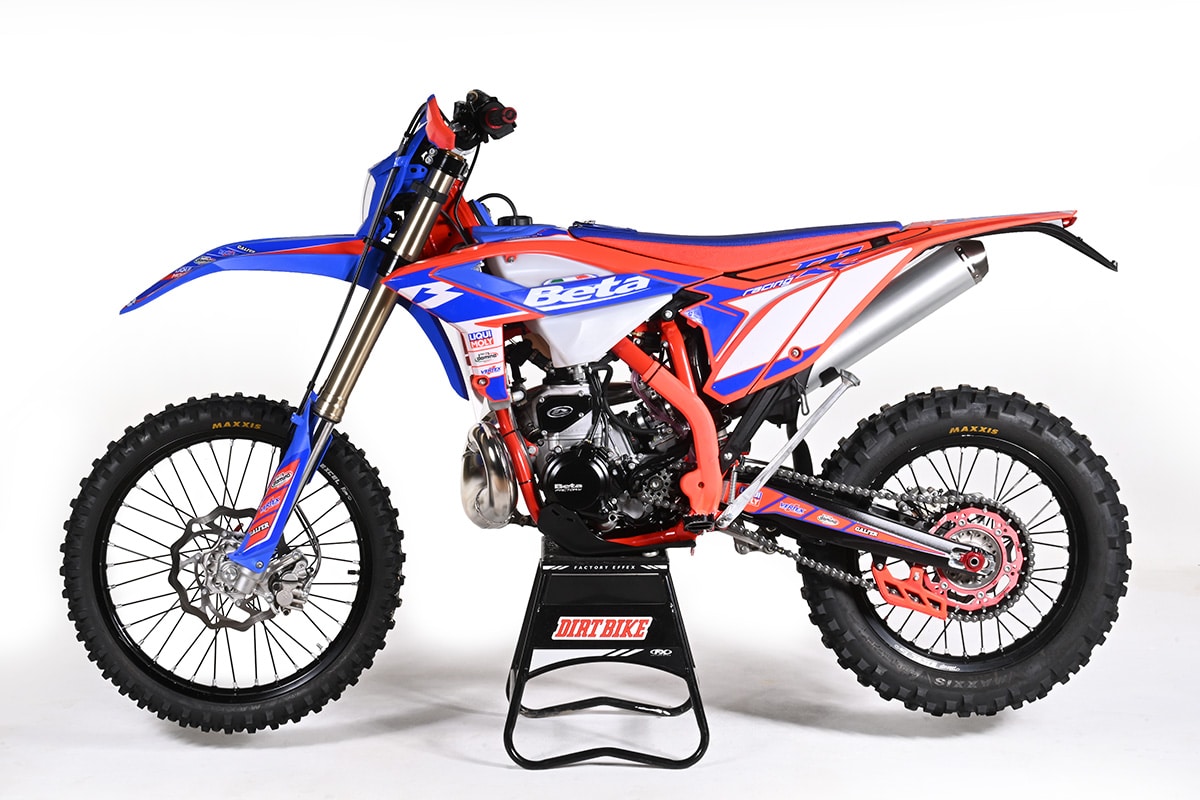For a few weeks we’ve been riding the Beta 300RR two-stroke Race Edition. One of the most interesting things about this bike is that it now has a twin-spark-plug ignition. That’s in addition to the features that Beta puts on all its Race Editions, which include KYB suspension and a lengthy list of detail upgrades. Beta’s Race Edition two-strokes also do away with the oil injection that is present on standard RR models, pushing the traditional technology theme even further.
You probably know that twin-spark-plug motors are not new. The concept was fairly common on motorcycles in the ’70s. Back then, the thinking was that large motors needed two flash points for thorough combustion. The problem was that the ignition systems of the time really weren’t that powerful, and we soon learned that one powerful spark was better than two feeble sparks. Now, fast-forward to 2024 and motorcycle ignition systems have come a long way. The Kokusan generators and ignitions that come on virtually all modern two-strokes are sooo much better than the junk we had back in the day. So Beta engineers decided to revisit an old concept. The twin-spark-plug ignition is only available on the 300 Race Edition, which is the most expensive two-stroke in the company’s lineup at $10,399. For that you also get a quick-release front axle, handguards, aluminum footpegs, a bi-metal sprocket and a bunch of anodized goodies.
Technical riding at low speed is the stronghold of almost all 300 two-strokes, but the Beta goes a step further than most. The power delivery is smooth and unstoppable. Beta’s experience in the trials world means the company knows something about making gentle, tractable power at very low rpm. When you’re in rocks the size of bowling balls, the Beta somehow finds a way to hook up and minimize wheelspin, even if your throttle control is sloppy. It’s still a powerful bike, but it doesn’t feel especially brutal on top because it’s so smooth and sweet. Another aspect of the 300RR motor that’s impressive is how well it’s jetted and how much latitude that jetting offers. It doesn’t ping, detonate or miss a beat. In our time with the bike, temperatures ranged from the 50s to the 90s. It ran the same. We also used it from sea level to 4000 feet without feeling the need to re-jet. That was unheard of in the old days. We can credit the Keihin PWK for some of that, but we also believe it’s about the aforementioned advancement in ignition systems. What the twin-spark-plug design brings to the table is difficult to say without back-to-back testing, but we understand that dyno figures show a slight improvement. We also know that in the aircraft world,there’s a dramatic decrease in output when you manually disable the second set of spark plugs. Is that apples-to-apples? No, but it demonstrates that a dual-plug system can be more efficient. We’re going to keep riding the Beta until someone comes and pries it from our fingers. The test will appear in the August, 2024 print edition of Dirt Bike.

RICKY BRABEC WINS ARGENTINE DESAFIO RALLY
Ricky Brabec took Honda’s 10th win at the Argentine Desafio Ruta 40 Rally today as Honda took a 1-2-34 sweep of the top places. American Skyler Howes was fourth.
Ricky Brabec: “It’s been a big final week, it’s been stressful but it’s good to be back. The team rode really well, the mechanics did a good job and so I think we’re in great shape heading to Morocco. It was a great day, although it was stressful as I didn’t want to lose all the time I’d made up and Tosha put some time on me today as he’s good at this road style rallying and I’m not the best at it. But I tried my best to not lose too much time and in the end everything came out pretty well. This has been a really good confidence booster moving forward and so I’ll be happy to get home and do some more testing with the bike and make it another level better. The Honda CRF450 Rally is doing its job and we’re all happy with the bike.”

Rider StandingsPROVISIONAL STANDINGS AFTER STAGE 5
|
BACK IN THE DAY: 2010 USGP

Whenever we go back into the DB archives it’s a big adventure. The 2010 USGP folder fell out on the floor yesterday and it was fascinating. Back then, the four-stroke engine design had only recently established itself as the platform of the future and already more changes appeared to be coming. Antonio Cairoli came to America for the sixth MXGP of the year and he was leading the points standings on, of all things, a KTM 350SX-F. KTM believed at the time that the 350 would soon dominate pro motocross and was making a very good case. Cairoli pulled the first moto holeshot against a field of 450s. Only Mike Alessi was close, and he was also riding a KTM 350. The two riders would finish 1-2 overall that day and Cairoli would go on to win five consecutive MXGP championships on the 350. Alessi’s future on the 350 wasn’t as colorful. He pulled a holeshot at the Hangtown National MX the next week and finished second overall, but that was one of few highlights. The next year he switched to the KTM 450SX-F.

By 2015, the 350’s run in motocross was over. The newest generation of 450s were just as light and had very manageable power. Cairoli switched to a 450 for his final championship in 2017. In off-road racing, however, the 350 continues to stack up wins and championships even now.
That day in 2010 did point to some future trends. Marvin Musquin won the MX2 class over Zach Osborne. Ken Roczen was fourth in a field that included Jeff Herlings, Max Anstie and Vince Friese. The spectator turnout, unfortunately, was mediocre. Fans pointed to the absence of true star power. If only they knew.




CAN-AM CHAMPIONS

Going back a little further in time there’s a great photo of Gary Jones’ 1974 Championship-winning Can-Am 250. That was a wild time in motocross. Can-Am actually took the top three places in the 250 class with Marty Tripes second and Jimmy Ellis third. Tripes won more races than anyone but did it all on a Husqvarna. He wasn’t hired by Can-Am until the very last race. Don Jones (Gary’s dad) was the Can-Am team manager and he hired Tripes at the end of the year so they could carry the 1, 2 and 3 number plates in 1975. It didn’t work out that way, though. Gary broke his leg at Daytona before the real National season began. Marty Tripes moved on to Bultaco. In 1975, Jimmy Ellis was the last man standing at Can-Am. He swept the entire Supercross season and to this day, remains the only man to have accomplished that feat. To be fair, the series only had four races.
See you next week!








Comments are closed.